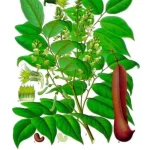Vanilla planifolia, commonly known as Vanilla, is a plant renowned for its aromatic beans used in various culinary and medicinal applications.
While it is prized for its flavour and fragrance, it can also cause skin irritation resembling poison oak in some individuals.
This remedy is derived from the Vanilla beans and is used in homeopathy to treat specific conditions.

Table of Contents
ToggleSOURCE INFORMATION
Scientific Classification
- Kingdom: Plantae
- Family: Orchidaceae
- Genus: Vanilla
- Species: Vanilla planifolia
Origin
- Vanilla planifolia, commonly known as Vanilla, is native to Mexico and Central America.
- It grows as a vine in tropical climates, typically found in forested areas.
- The plant requires a warm and humid environment to thrive, making it well-suited for cultivation in regions with tropical or subtropical climates.
Historical Facts
- Vanilla has a rich history dating back to ancient Mesoamerican civilizations, including the Aztecs and the Maya. These indigenous peoples used Vanilla both as a flavouring agent and as a ceremonial offering.
- The Aztecs referred to Vanilla as “Tlilxochitl,” meaning black flower, and believed it to have aphrodisiac properties.
- Spanish conquistadors, including Hernán Cortés, encountered Vanilla during their conquest of Mexico in the 16th century. They introduced Vanilla to Europe, where it gained popularity as a flavouring agent.
- Vanilla became highly sought after in Europe and was initially cultivated in Madagascar, Réunion, and other tropical regions outside of its native habitat.
- Today, Vanilla is one of the most widely used flavourings in the world, with applications in culinary, perfumery, and cosmetic industries.
DRUG PATHOGENESIS
Vanilla can cause marked skin irritation similar to poison oak, especially when the beans are handled directly or when vanilla essence is used topically.
Workers exposed to Vanilla may experience various nervous system and circulatory disorders.
It is believed to have stimulating effects on the brain and sexual propensities.
DOCTRINE OF SIGNATURE OF VANILLA-PLANTIFOLIA
The Doctrine of Signatures suggests that plants or substances resemble the parts of the body they are meant to treat or have an affinity for.
In the case of Vanilla planifolia, its long, slender pods bear a resemblance to certain anatomical features, particularly the male reproductive organ.
This resemblance has led to the belief that Vanilla possesses properties that can influence sexual health and stimulate sexual propensities.
Therefore, according to the Doctrine of Signatures, Vanilla’s physical appearance suggests its potential efficacy as an aphrodisiac or enhancer of sexual function.
KEY CHARACTERISTICS
- Skin Irritation: Vanilla can cause skin irritation resembling poison oak.
- Nervous System and Circulatory Disorders: Workers exposed to Vanilla may experience disorders related to the nervous system and circulation.
- Emmenagogue and Aphrodisiac: Vanilla is believed to have emmenagogue properties (A substance that stimulates or increases menstrual flow), prolonging menstrual periods, and acting as an aphrodisiac (A substance that enhances sexual desire or libido), stimulating sexual propensities.
MODALITIES
Skin irritation may be exacerbated by direct handling of Vanilla beans or by topical application of vanilla essence. Symptoms related to the nervous system and circulation may worsen with prolonged exposure to Vanilla.
DOSE
Vanilla is typically prescribed in homeopathic potencies ranging from 6th to 30th.
These potencies have been found effective in treating skin affections caused by Vanilla.
FREQUENTLY ASKED QUESTIONS
What are the principal uses of Vanilla in homeopathy?
- Vanilla is primarily used to treat skin affections resembling poison oak and may also be beneficial for nervous system and circulatory disorders.
What are some common symptoms indicating the need for Vanilla?
- Common symptoms include skin irritation resembling poison oak, nervous system disorders, and circulatory disorders.
Are there any precautions to consider when using Vanilla as a remedy?
- It is important to avoid synthetic Vanilla extracts and handle Vanilla beans cautiously to prevent skin irritation.













Leave a Reply